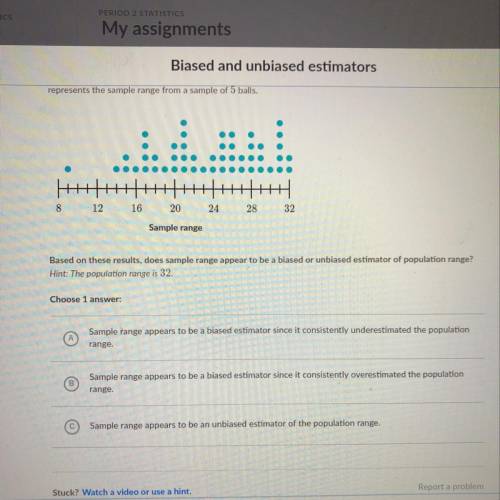
Mathematics, 05.06.2020 02:59 Keelana
Ekene was curious if sample range was an unbiased estimator of population range. She placed ping pong balls
numbered from 0 to 32 in a drum and mixed them well. Note that the range of the population is 32.
She then took a random sample of 5 balls and calculated the range of the sample. She replaced the balls and
repeated this process for a total of 50 trials. Her results are summarized in the dotplot below, where each dot
represents the sample range from a sample of 5 balls.
.
ea
8
12
16
20
24
28
32
Sample range
Based on these results, does sample range appear to be a biased or unbiased estimator of population range?
Hint: The population range is 32.
Choose 1
Sample range appears to be a biased estimator since it consistently underestimated the population


Answers: 1


Another question on Mathematics

Mathematics, 21.06.2019 13:30
Cynthia takes her dog to the park every 2 days. she bathes her dog every 7 days. if she took her dog to the park and bathed him today, how long will it be until she does both on the same day again?
Answers: 2


Mathematics, 22.06.2019 03:40
Assume that females have pulse rates that are normally distributed with a mean of mu equals 72.0 beats per minute and a standard deviation of sigma equals 12.5 beats per minute. complete parts (a) through (c) below. a. if 1 adult female is randomly selected, find the probability that her pulse rate is between 65 beats per minute and 79 beats per minute. the probability is? b. if 16 adult females are randomly selected, find the probability that they have pulse rates with a mean between 65 beats per minute and 79 beats per minute. the probability is? c. why can the normal distribution be used in part (b), even though the sample size does not exceed 30?
Answers: 3

Mathematics, 22.06.2019 07:20
Greg is designing a clock face. using the center of the clock as the origin, he keeps its diameters at 10 units. match the positions for the hours on the clock face to their corresponding coordinates. 3 o'clock (0,-5) 6 o'clock (5,0) 9 o'clock (0,5) 12 o'clock (-5,0)
Answers: 2
You know the right answer?
Ekene was curious if sample range was an unbiased estimator of population range. She placed ping pon...
Questions





Mathematics, 04.02.2021 20:00

Mathematics, 04.02.2021 20:00


English, 04.02.2021 20:00


English, 04.02.2021 20:00



Social Studies, 04.02.2021 20:00


Biology, 04.02.2021 20:00

Mathematics, 04.02.2021 20:00


History, 04.02.2021 20:00


Mathematics, 04.02.2021 20:00



